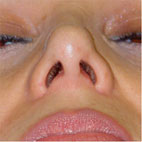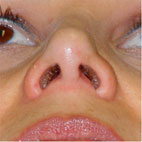
Open rhinoplasty
A little history of open rhinoplasty
Open rhinoplasty is not a new technique: in 1934 a surgeon from Budapest called Rethi described a surgery in which he modified the tip of the nose by means of a skin incision through the columella. In the following years surgeons like Sercer and Padovan of Zagreb perfected the technique, but it's popularity and diffusion can be most attributed to the American surgeon Jack Anderson. In the 80's Johnson and Toriumi introduced the principle of open structure rhinoplasty according to which the modifications to the external shape are carried out guaranteeing absolute respect of the supporting structures of the nose. These structures indeed are the first, in the case of fragility or absence, to be reconstructed.
A catalyst in the spread of open rhinoplasty in Italy were courses directed by Dr. Sebastiano Sciuto, author of the scientific contents of this site, who directs biennially "Nose & Surroundings", a course of aesthetic and functional surgery of the nose in which, since 1993, hundreds of Italian and foreign surgeons have participated.
What does open rhinoplasty consist of?
Open rhinoplasty is carried out through a small incision in the columella. This incision, visible only from below, is almost invisible when healed.
Through the columellar incision all the nasal structures are exposed: the alar cartilages, the triangular cartilages, the nasal valve, the septum and the bony bridge. This way the surgeon can examine and evaluate any anomaly of shape, any asymmetry or structural alteration. The various components of the nasal structure can thus be corrected with great accuracy. Grafts and sutures can be placed in the correct place with extreme precision. According to the surgical philosophy of open structure rhinoplasty the operation is more respectful of the nasal anatomy today than it once was: the most recent tendency is that of limited resections and maintaining the support structures of the nose intact, while the changes of shape are obtained with the use of grafts or sutures..
 |
 |
 |
Does open rhinoplasty leave scars?
Open rhinoplasty is carried out, as already mentioned, through a small cut situated about half way on the columella, that is, the pillar that separates the two nostrils. To avoid any scar a specific type of incision in the shape of a "W" or a stairway is used. The stitches are executed with very thin thread and already after 2-3 weeks the scar is already nearly imperceptible, and will become practically invisible when healed completely.
 |
 |
 |
 |
| Preoperative | 3 months | 8 months | 1 year |
Open rhinoplasty or closed rhinoplasty: which is the better technique?
It is a mistake to think that one technique is better than the other: there is no maneuver or feasible surgical procedure with the open approach that cannot also be used with the closed technique and vice-versa. A lot depends on the inclination of the surgeon: supporters of the open technique (including the author) think that the direct view of the nasal structures gives great advantages in terms of precision and accuracy.
With open rhinoplasty the placement of grafts, sometimes useful also in the case of primary rhinoplasty, is more straightforward. In the case of secondary rhinoplasty, the open technique becomes almost indispensable, since the surgeon, through the direct view of the nasal structures, can see and understand the defect in an undeniable way and consequently the correction can be more precise.